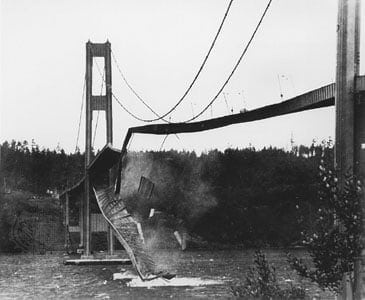 On the 7th of November 1940, the Tacoma Narrows Bridge collapsed during a windstorm. The wind created intense vibration and the bridge fell apart. Wind and vibration had previously been an afterthought. But the collapse changed suspension bridge design and engineering forever.
On the 7th of November 1940, the Tacoma Narrows Bridge collapsed during a windstorm. The wind created intense vibration and the bridge fell apart. Wind and vibration had previously been an afterthought. But the collapse changed suspension bridge design and engineering forever.
Today, the Tacoma Narrows Bridge collapse is required study for every bridge engineering student.
Much like the ill-fated bridge, many pressure sensors are not designed to withstand vibration or shock.
Understanding Shock and Vibration
Two of the most powerful and daunting forces that a pressure transducer must endure are shock and vibration. Each can destroy a pressure sensor if it’s not built to withstand the beating – a lesson that’s too often learned the hard way.
It’s worth noting that shock and vibration are not the same. Vibration is a sustained frequency while shock is a momentary impact. However, each requires a hardened sensor design and construction.
Shock is usually the result of dropping the sensor, hitting it with a tool (such as a hammer), over-tightening, and water hammer.
Vibration is typically caused by equipment, such as pumps and motors. It can also be the result of repetitive shock, such as frequent and consistent water hammer.
Withstanding the Blows
Most of our pressure transducers are built to withstand process related shock and vibration. The sensors in our hammer union family are even built to withstand extremely rough handling and direct hits.
How do we do it?
First, we tie everything down. Everything is connected so that it vibrates as one unit. Any loose ends will eventually lead to a broken connection.
For even better protection, we fill the inside of the sensor housing (or “can”) with a hardening gel called potting. The potting fills all the gaps and encases the internal wires and electronics into a single mold.
We also build the sensor housings as tough as we can. Typically, we use laser welds to put the sensor together. But some sensors have screws to provide access for repairs and adjustments. When we have to use screws, each is sealed with an industrial thread-locking fluid.
No Longer An Afterthought
It’s important that you consider the vibration and shock that your pressure sensor might experience. There are potential threats at each stage of your sensor’s lifecycle. Ask yourselves the following questions:
If high vibrations and shock are a concern, look for a heavy-duty sensor that is specifically designed to perform well and endure in a vibrating environment.
Reach out to us if you have questions. We work very closely with customer in very harsh conditions where extreme shock and violent vibrations are a daily occurrence. And we’re happy to point you in the right direction when our sensors aren’t a great fit (it happens to the best of us).